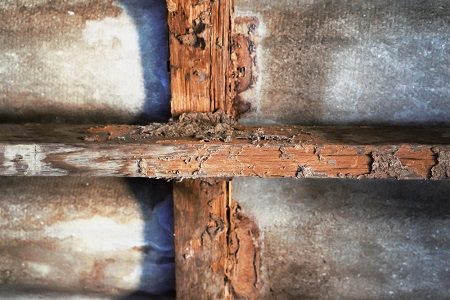What Does a Termite Infestation Look Like? Know the Signs!
 Most of the time, a termite infestation goes undetected until severe damage is done to the property. The signs of termite infestation are not very obvious and to find it at an early stage, you will have to be consciously looking for it. Once you find it early, you spend much less on termite damage repair.
Most of the time, a termite infestation goes undetected until severe damage is done to the property. The signs of termite infestation are not very obvious and to find it at an early stage, you will have to be consciously looking for it. Once you find it early, you spend much less on termite damage repair.
Why Is It Important to Find a Termite Infestation Early?
Termites live in colonies and usually, the number can range up to two million termites in a single colony. Termites eat 24/7 and do it without being detected. Now, this can cause significant structural damage to the property in the long run. There are instances when houses have had to be completely rebuilt because of termite damage.
The best way to keep termites away or identify termite activity early in your property is to schedule an annual termite inspection. If you live in a coastal or termite-prone area, then it would be best to schedule the termite inspection twice every year.
Apart from this, it also helps to be vigilant at all times. Know the signs of a termite infestation and keep your eyes open for these signs. When you note the signs and suspect termite activity on your property, immediately schedule a termite inspection. The termite inspector will know where to look for the colony and will also suggest a suitable termite treatment to get rid of the same.
Signs of Termite Infestation
Termites are pros at staying hidden and it doesn’t help that they like dark and damp places. It is very rare for people to spot actual termites. It is mostly the signs that warn us about the termite infestation on a property. Here are some of the signs that you should know about:
Mud Tubes
This is the most common indicator of termite invasion on your property. Subterranean termites are most prevalent in the United States and mud tubes are their medium of travel.
These species of termites need moisture to survive and hence they build their nests in the ground. They use their saliva and mud to form tunnels through which they travel to find food.
You might note vein-like mud tubes spreading through the walls, foundation, wooden furniture, and even floors. These mud tubes not only help the termites travel but also protect them from predators like ants.
Termite Droppings
Termites eat and thus have to defecate. These droppings might be inside the wooden furniture or the floor (depending on the area of infestation) making spotting them very unlikely.
Termite droppings look like sawdust and are called frass. They are wood-colored and can be easily mistaken for wood dust. While cleaning your property, make sure that you check the area out for this.
Dried Mud Formations or Mud Spots on Walls or Ceilings
Formosan termites tend to build swarm castles while preparing for spring. These odd formations made of wood, mud, and saliva usually protrude from the walls or ceilings. It signals the need for termite treatment on your property. You might also note the floors sinking and sagging of the ceilings.
Pin-Sized Holes and Sinking-in Wallpapers
Termites tend to create small escape holes while eating through the wood paneling and cardboard of your walls. Sometimes, you will note the wallpapers sinking or giving in. This is a sign of termite galleries being present on the walls.
Stuck Windows and Doors
Windows and doors provide termites with easy access to wood since they are exposed. Termite damage on doors and windows can cause the frames to warp making them hard to close or open.
Your windows or doors may also be stuck because of the winter season. Hence, let the professional termite inspector do the work.
Also Read: The Life Cycle of a Termite and Warning Signs of Termite Damage
Damaged Wood
Wood is the primary food source for termites and thus regular checking of the wooden items might help find the infestation early.
You will find tiny holes or even note tunnel-like carvings on the wood surface. This means that termites are slowly eating away the wooden furniture. During moments of silence, you might also note scraping noises from wooden things.
If you notice damage to a wooden surface, tap the surface and if you notice a hollow sound, then it is time to call a termite inspector.
Termite Swarmers and Discarded Wings
Termites mate and create colonies during late monsoon since they need a warm and humid climate. If you are noticing winged termites flying in groups near your home, then it might be a sign of a budding infestation.
Swarmers shed their wings once they find a place to start their colony. Piles of discarded wings inside or close to your home might signal the start of a termite infestation on your property.
HiTech Termite Control of the Bay Area
Termites can prove to be a nightmare, especially when the infestation is severe. We at HiTech Termite Control, use advanced techniques to get rid of termite infestations in Bay Area homes. Check out the services we offer here.
- Nov 18, 2022
